by Tom Gaylord
Writing as B.B. Pelletier
This report covers:
- Two basic types of pistons
- Center-latched pistons
- Side-latched piston
- See the difference?
- Gas springs
I’m going to look at how triggers interact with pistons in spring guns today. I thought some of the blog readers may not be aware of some of the subtleties of sears and triggers as they relate to pistons.
Two basic types of pistons
Spring pistons are latched or “caught” by their sears in 2 different ways. These 2 ways are so vastly different that they dictate what types of triggers will work with what types of pistons. Until you understand the differences, you can’t appreciate why certain triggers such as the Rekord won’t work with certain types of pistons.
Center-latched pistons
A center-latched piston has a rod in its center that in some way gets latched or “caught” by the sear. When it’s latched, the sear restrains the full force of the mainspring. That can be well over 100 lbs. of force in the case of a coiled steel spring, or several hundred psi of gas pressure in the 2-piece expanding cylinder of a gas spring. The sear prevents the piston from moving until it’s released by the action of the trigger.
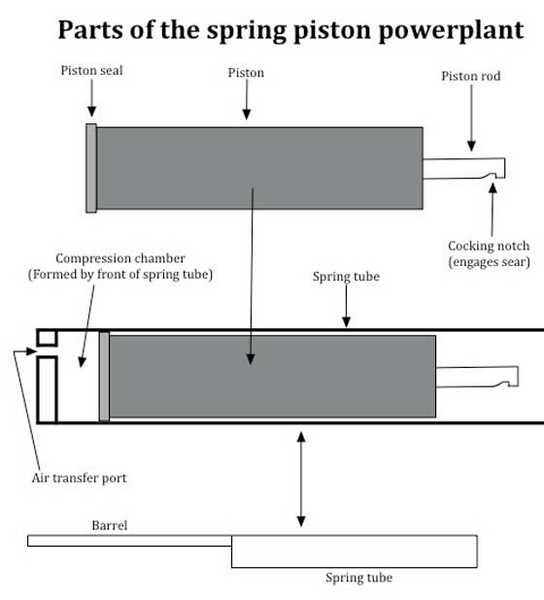
This drawing shows the piston rod with its notch, which catches the sear.

Here’s a piston with a center-latching piston rod. Pardon the crud, but this came out of a very dirty rifle.
Any trigger that holds this kind of piston has to catch that notch in the piston rod. The Rekord trigger is the most famous, but there are hundreds of different triggers that do the same thing.
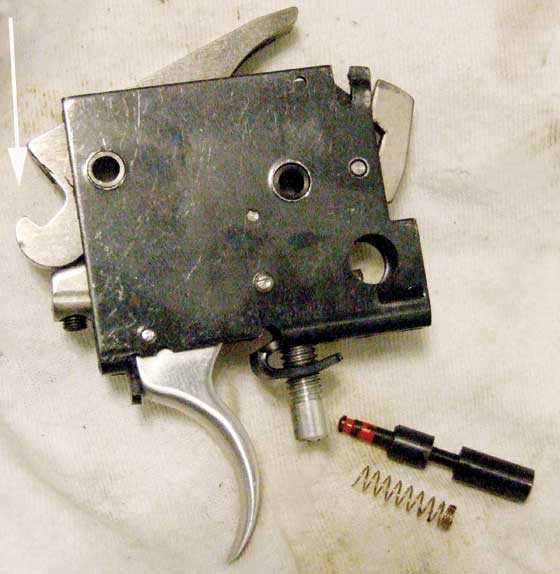
The Rekord trigger has a latch that catches the notch in a piston rod (arrow). When the gun is cocked, the piston rod pushes down on the long silver lever, bringing its latch up into engagement with the notch in the piston rod. The separate pin and spring are the safety.
Another type of center-latched rod uses 3 ball-bearings that are forced into a groove in the end of the piston rod. The sear holds the metal cage that holds tension on these 3 bearings. When the trigger releases the sear, the cage moves, releasing the ball bearings. The effect is the same as far as the shooter’s concerned. The piston is pushed forward by the spring.
Diana’s ball bearing trigger is crisp and easy to adjust, but the design was overly complex to build.
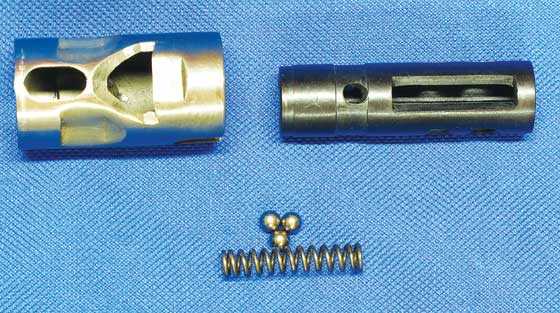
These parts make up the Diana ball bearing trigger. The black cage slides inside the silver cage and forces the ball bearings into the groove of the piston rod.
Side-latched piston
Now that we understand how the center-latched piston works, let’s talk about the side-latched piston. As the name says, the side-latched piston contacts the sear on its side rather than on a central rod. There may still be a central rod to guide the mainspring, but the sear doesn’t contact it. The sear contacts a spot on the rear skirt of the piston, where a notch has been ground. The Diana model 45 rifle that I recently tuned has a side-latched piston. A notch is ground into the rear skirt of the piston (looks like a window), and that’s what the sear catches when the rifle’s cocked.
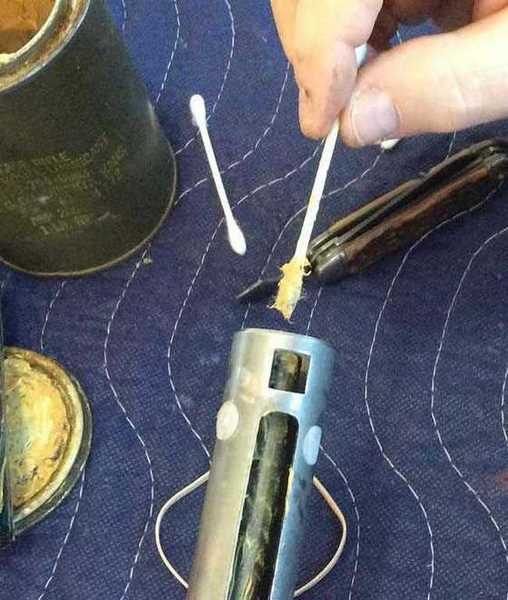
This is the rear of the Diana 45 piston, and the square hole in the piston skirt is what the sear catches. Notice that there’s a piston rod, but it’s only a spring guide.
The side-latched piston has to be kept aligned with the sear so it’ll catch. The cocking slot is what holds the piston from rotating inside the spring tube. Side-latched pistons aren’t nearly as common as centrally latched pistons. They’re usually found in families of airguns, because one trigger unit works with all of them.
See the difference?
Now that you understand the 2 different piston-latching methods, do you see how the trigger for a centrally latched piston would not work with a side-latched piston? The sear would be in the wrong place.
Gas springs
The pistons in gas-spring units all latch on the side. It’s impossible to convert a side-latched gas spring to work in a spring gun that has a centrally latched piston. Or, if not impossible, it hasn’t been done to my knowledge. Maybe someone has done it. If so, they’re keeping it a secret.
There’s a lot more to triggers and pistons that I haven’t touched on in this report, but now you should know the differences between the centrally latched and side-latched pistons.

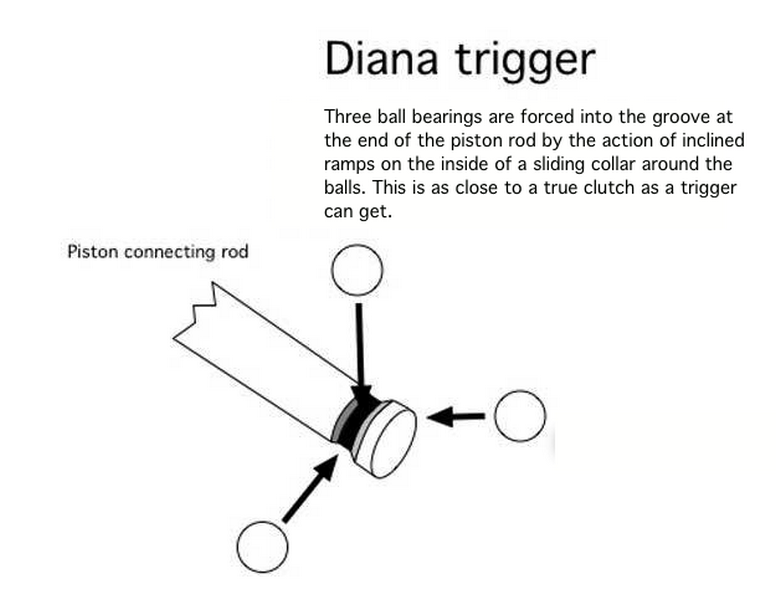
Hi BB, and thanks for the tutorial . I recently acquired Webley Tempest and for the life of me can not shoot it , getting any kind of groups. I am talking about shots 4 to six inches apart, shooting at ten meters. At closer ranges, the variance is less, but still terrible. I have read you article on shooting the Tempest and have tried more relaxed holds to no avail. Locally all I can buy is Crosman pointed hunting pellets and Crosman hollow point hunting pellets.
I should add that the pistol is 22 calibre version. it is such a well made compact pistol, hate to give up on it, so any suggestions sure will be appreciated. Thank you . Harvey
Hi Harvey, if your tempest is an over lever style, not the oddball Tempest 2, it’s inherantly accurate…..and a swine to shoot accurately….
First stop is some pellets that suit it…..try buying some JSB Exact….in the light variety and some RWS Superdomes…..the high antimony of Crosman pellets makes them quite hard and not always suited to lower powered gun, especially if its an earlier British model who’s barrel may be a “true” 22 rather than 5.5mm
Then it’s practice, practice, practice, the recoil is strange on them, with an unusual amount of muzzle flip, so you need to develop a repeatable grip.
I wouldn’t expect too much from any spring piston pistol, 15 to 20 yards, from a rested position is your lot really
Hi Harvey, as noted by others, the Tempest is a hard pistol to shoot well, but it does have some decent inherent accuracy. I bought my first .177 caliber version back in the 80s from Beeman; at that time, they rated the 25 foot accuracy as .75″ and that is about what I was able to wring from the gun, but only after a lot of practice. That gun liked H&N match pellets. I wound up giving that one away, but inherited a second one from my Dad, also a .177 caliber. This one seems a bit more accurate; on my indoor 5 meter range, I can often get one ragged hole groups, but it takes a LOT of concentration, not just on a smooth rearward trigger pull but also on having a VERY consistent grip. I use a firm grip; it seems to work better than a lax one, but it has to be the same every time…not easy, but challenging! The cool thing is, when you can shoot your Tempest well, all other pistols will seem quite easy to shoot by comparison. Also, on this second Tempest, I had to try about 8 or so different pellets till I found one it really liked; in this case JSB exacts (light weight). While I have a customized Crosman 1322 with a 12″ barrel that blows it away for accuracy and ease of shooting, I love my Tempest; it’s a gift from my Dad, it’s a classic, it’s fun to shoot, and it really forces you to perfect your form. All I can say is shoot it a lot once you find pellets it likes, and the more you do, the more you will like your Tempest.
take care,
dave
Thank you Dave and I appreciate your thoughts and observations. I will try some of the pellets you recommend.
The pistol with it’s unique looks sure is a interesting pistol.
Thanks again
Harvey
You are most welcome.
Thank you Dom for your reply. I will order some lighter softer pellets and give it a try. I am the 3rd owner of this new 22 Tempest, made in Turkey. I have other pistols that shoot better then i can. Among them are the Beeman P17, Crosman 2240, and Webley Alecto. This little pistol just makes me feel good holding it,and then shooting, much disappointment . Thanks again !
Harvey!
The Webley Tempest/Hurricane pistols are famous for their heavy trigger pull. The reason is that Webley used the same spring as both trigger spring and barrel catch plunger spring.
When you release the barrel, you will notice that the barrel catch plunger spring is very heavy. Why Webley used this spring also as a trigger spring is not easy to understand. I included a link to a drawing so you can check for yourself. It is part number T16. (The Hurricane has a click adjustable rear sight.)
http://i165.photobucket.com/albums/u70/Garvin1/WebleyHurricaneCustom.jpg
The trigger is adjustable. By turning the hex screw behind the trigger anticlockwise, the tension of the trigger spring will be released. This will make the trigger pull a lot easier, which also will improve accuracy. I will recommend that you replace the trigger spring for a much better pull.
The Webley Tempest/Hurricane air pistols are fun to shoot and were basically made as training pistols, since they recoil in the same way as a powder burner. They are not for made competition shooting. At 10 meters (11 yards) expect accuracy to be within 5 cm (2 inches). With replaced trigger spring and the right pellets I manage about one inch (or slightly larger) at 10 meters.
Eddie
Hi Eddie, thank you for your comments and link for the Webley Tempest. If i could get the 2 inch group right now, I would be thrilled 🙂
Trying different pellets will be my next step The trigger pull on mine is not too hard, much easier then my Umarex Browning Buck Mark, but it feels like a single stage. Initial resistance and then bang, it releases. The pistol is a keeper, with it’s construction and classic looks. Thanks again !
Harvey,
Crosman pellets are wrong for a Tempest. It needs larger soft lead pellets. Even Daisy pointed pellets would be better.
I shoot 5.56mm pellets in my Senior, but it’s very old. I think your Tempest has a smaller bore. Hobbys should be good in it.
B.B.
Hi BB and thank you for your suggestion. I will order some Hobby’s and see how they do. Amazing to me how different pellets can affect a pistol’s accuracy. Best wishes to you and Edith.
Harvey
Harvey,
The Tempest is a hard pistol to shoot. It will never be a paper puncher. Instead it is a can shooter. But with practice, you can it cans at 25 to 30 yards. The way I leaned to shoot my Tempest was to hang a coke can at 5 yards and shoot until that became easy. Then I backed up to 10 yards, 15 yards, etc. I like shooting the Tempest because it is hard to shoot. I never could do very well past 30 yards with my Tempest. If you can take joy from popping a can, the Tempest is a lot of fun. If you have to shoot tight groups, I don’t think you will ever be happy with the Tempest.
David Enoch
Hi David, Several of my friends and I get together weekly , shooting the sight and see targets at ten meters. I think they are 3 inches in diameter. Very seldom do I ever hit them with the Tempest. I do ok with my other pistols and even with my Legends P08 blowback BB pistol can get at least 1/2 clip into the black. When the weather warms up more I will try your pop can idea. Sounds like fun. With my age and eyesight, I do not aspire to be a champion paper puncher, so the tin cans at ten meters would be great. Thanks again.
BB,
Is the piston rod and piston a single unit that cannot be separated easily? Specifically the ones in our current Diana airguns and TX200 airguns?
Joe,
The rod is permanently attached to the piston. To remove it takes some machining and each piston is different in that respect.
B.B.
BB
I believe your last paragraph was referring to a coil spring piston gun not a gas spring piston gun as all gas spring guns I have seen and worked on are latched on the side of the piston.
Unless I misread the paragraph or have missed something I do not believe a gas spring can be latched ion the center as the gas spring housing and rod have no provision for the sear to latch hold on the piston but the side of the piston.
Please correct me if I misread or am not understanding the message in the last paragraph.
BD
Same thought on me too… I believe most of gas rams are latched on the side.
BD,
Good catch! I swapped my terms in that sentence!
I corrected it. Thanks!
B.B.
BB
Thank you as I thought I was losing my mind and reread the last paragraph over and over to be sure I was reading it correctly.
So at least I know my mind is still in my head somewhere as I thought it had run away like most of the rest of my usable body parts and functions.
BD
For some reason, this morning when I click on my shortcut for this blog, I end up at Pyramyd AIR and have to take the shortcut from there to get here.
I had the same problem; very strange.
Christoph,
See my reply to RidgeRunner.
Thanks,
Edith
Christoph,
The link works, again.
Edith
RidgeRunner,
I believe your shortcut/bookmark is for /blog//. Someone at Pyramyd AIR must have changed that so it goes directly to the retail site. The only bookmark that currently works is pyramydair.com/blog (minus the airgun-academy.) part. If you don’t know how to change the link address for a bookmark/shortcut, don’t despair. I’ve emailed Pyramyd Air’s IT department and asked them to redirect the old link to the blog home page instead of the retail site’s home page. This also affects the old link in search engines, which is not good.
Thanks for alerting us!
Edith
RidgeRunner,
The old link in your bookmark/favorites will take you to the blog, again.
Edith
BB,
I am having a really difficult time picturing in my mind how a gas piston setup can work in a center latch system.
I would think it would be much easier to convert a side latch piston sproinger to a gas spring.
If you want to complicate matters even more — you have to consider the part that was left out of the report: the piston rod goes through a hole in the back of the spring tube before latching (needed to keep the rear of the spring out of the way).
But on a gas strut, that rod is the non-moving part of the assembly. You’d need to fit a sleeve around it on which the sear mechanism can catch. But given the loads on the system, that sleeve would have to be nearly the diameter of the piston itself, at which time you’ve essentially turned the action into a side-latch model.
Baron,
Yes, I have taken a few apart.
Actually I was trying a bit of humor and sarcasm to alert BB that he had things backward in his last paragraph about gas sproings and how they latch. After he woke up this morning, he corrected it.
B.B.
Any new new news on the Diana 45 tune?
Has it smoothed out any since last test?
I think mine needs its barrel bent. It shoots to the right and the scope is maxed out.
Rob,
I will be reporting on it again soon.
It’s still shooting about the same as it did after the tune.
B.B.
Christoph and RidgeRunner,
I had no such problems. Can we assume that all “gas ram” conversions are only to side latching trigger systems?
Thanks,
Yogi
Yogi,
How about we assume that the present industry standard is for a side latch piston when using a gas sproing?
😉
B.B.
Basics form the foundation of profound knowledge. Thanks for such articles, they mean a lot for educating people!
I’d also add 2 points:
1) Slightly modified Rekord schematics is also used in side-latch type of springers, most known is Hatsan Quattro
2) There’s yet another form of side latch present in Russian Izh-38 and MP-512 rifles – let’s call it “side hook”
And, he-he, there are at least 2 types of center-latch gas springs (or, rather, 5 types). Well, as usual, if something seems to be impossible, ask Russians for the solution.
Type A and B1, B2 – let’s call it “steroid Diana” – gas ram rod protrudes through the bushing in the central “mushroom” of the piston rod. Locking principle is that of Diana or Rekord but enlarged “mushroom” or notch. Hi-pressure gas ram can be installed inside the piston or the piston itself works as a body of hi-pressure or low-pressure gas spring.
Type C and C1 – twin or triple-rod gas rams, with rods surrounding the piston rod. As for the body of the gas ram itself, it is the same as for A and B cases – separate or piston-spring combo.
duskwight
Duskwight,
Thank you for that information. Now I have learned something new.
B.B.
B.B.
Well, to be honest, in fact it’s not an “industry” solution, just some small series for local customization maniacs. Anyway, they do exist and they are well known – for huge price tag and tons of work mostly,
just like co-ax “holey” pistons, sliding on the barrel or other tech monstrosities.
Oh, and one more thing on notches for side-latch pistons. Most times it’s “tail”, where sear engages the notch, but there are also some models with “head” side notch – like mass-produced Izh-60 and Izh-53 pistol.
duskwight
Also used on the Walther LP53 (and its Lucznik clone.)
Paul in Liberty County
Hi BB,
The safety catch is kind of frozen on my Diana 460. Not allowing me to cock it. I called Umerex and they told me to send it back. Does anybody out there have any idea what it may be before I send it to Arkansas to be fixed? Any help would be appreciated!
ATB,
GAZ
Gaz,
Just a thought. Sometimes the gun cocks but the safety doesn’t set right. Give the underlever one hard tug as though cocking the rifle. It may set the safety. Works on sidelevers all the time.
B.B.
Is there any real advantage of one design over the other?
Home from work and started to shoot the new-to-me Walther LGM-2. It took me a while to figure out just what it was going from just memory of what I saw the first day at the gun show where I eventually bought it. It turned out to be even better than I thought. The rifle is impressive! I was shooting RWS R10 8.2 gr. and H & N Field Target Trophy 8.64 gr. .451 pellets. The range was 12 yards. Both shooting very well.
BTW, does anyone know what the “Go To” match pellet was for these rifles when they were used in the Olympics?
Mike
Mike,
The best way to find out what Olympians used is to look up past Olympic records. They often list the pellet that was used.
B.B.
Do center-latched pistons correspond with breakbarrel and underbarrel cocking and side latching with sidelever or is that a different subject. I take it that the piston sear is different from the trigger sear although the two seem connected is that right? Some day a discussion of just what a sear is might be useful although, this is happened and I either did not see the post or did not understand it.
Matt61
Cocking mechanism is totally separate — that is the means by which the piston is pushed back, compressing the spring. The sear is completely separate (other than possibly some form of anti-beartrap catch).
The sear in a spring gun is the interface between the end that latches the piston, and the end that jams against the trigger. For spring guns, looking at diagrams of the “nut” in a medieval crossbow may be the easiest thing to understand.
http://crossbow.wikia.com/wiki/Designing_medieval_nut_and_trigger_crossbow_locks
Now visualize the piston of an airgun catching on the top side of the nut…
That’s the basis of the simplest trigger/sear design. If you have an airgun with a two-stage trigger that seems to move /up/ into the stock as it is pulled, you have to add another lever between the trigger and the sear. During first stage travel, the angles of the trigger and intermediate lever are such that the trigger moves a long distance while moving the lever a short distance — then the second stage surface contacts the lever at a position where their is less mechanical advantage (the stacking in the trigger pull).
http://eddiecolwell.tzo.com/RWS-54.htm {Scroll down to the trigger engagement discussion} {This also applies to Gamo’s with a GRT-III trigger}
Note where the pivot points are — you can see why the trigger rises rather than moving backwards (the Rekord the blog shows has the pivot directly above the trigger blade, which gives a much nicer pull).
Matt,
There is some correlation as you suspect. It is centered on side-latched metal spring guns.
B.B.
Yesterday, I plunked down almost $50 for a box of .357 magnum only to find when I got home that it was actually .357 Sig. Argghh! No returns on ammo naturally. Who actually shoots this .357 Sig? I’ve never even heard of it before.
Matt61
The .357 SIG was developed as a Law Enforcement cartridge. It was to and does equal the power/effectiveness of the .357 revolver cartridge. While not that common, it is a very effective round. That said, some of the newest 9 mm Para. loadings are almost as good. It is often used in GLOCK pistols. If a person has a GLOCK in .40 S&W, it only takes the change of the barrel to shoot the .357 SIG in the same pistol. This is because the .357 SIG round is based on the .40 S&W case.
Mike
Would have made my life easier if they had just stuck with the .357 magnum. 🙁 Odd that this new round is almost as powerful. The case is a lot shorter.
Matt61
Indeed. Modern powders make the difference. Many of the older rounds (.357 Mag. is one) were developed from old black powder cases that needed the extra capacity. So, there can be a lot of waisted space with most modern powders. The .357 Mag. is too long to work well in most semi auto pistols. Hence the .357 SIG.
Mike
.357 Mag was developed for smokeless powders… The case is .10 inch longer than .38 Special to prevent putting the high pressure .357 into the older guns that wouldn’t handle it. Similarly, the .44 Mag is longer case to prevent use in weaker .44 Special guns.
.357/.44 are rounds that headspace on the rim. Most all semi-auto cartridges don’t have rims that extend wider than the main case diameter — they headspace on the mouth of the case (no roll crimp holding the bullet in).
As the name implies, the .357 SIG was created by SIG/Sauer (though it doesn’t surprise me that Glock would chamber it). Probably as an attempt to put .40S&W powder loads behind a 9mm/.357 bullet. (The original .40S&W has ballistics very close to the “western” .38-40 round — but fits into a 9mm sized semi-auto frame — something that can’t be said for the 10mm auto round)
Very true. Both the .357 Mag. and the .44 Mag. have their roots in the old black powder cartridges of the past.
Mike
Forgot to mention: you’ll want to avoid picking up the .357 Remington Maximum, the .357 Herrett, and the .35 Remington…
And, confusingly, the .357 SIG doesn’t use a .357 bullet — it uses .355 (9mm) bullets.
What velocity you should you expect with a talon 177 caliber 18 inch barrel with co2 and a 7.9 grain pellet?
B.B.,
This last weekend, “MIke”, asked for advice on the price of guns at a gun show.
The Blue Book suggested that a 40% was one price, and you quoted another higher price. Though it was (not) stated that the guns were at 40% condition, but,… since they were shooting club guns, one would assume that they have seen a lot of use.
((So I guess the question is, when you recommend a “good” price, or a “deal”, is that based on what that model is currently going for, regardless of what the Blue Book might indicate?))
I am thinking of running an ad in the local paper for vintage/quality air pistols and rifles. I would use the Blue Book as a guide and would offer accordingly with thoughts of re-sale.
Any basic thoughts on the matter?
Thanks, Chris
Chris,
Yes — basic thoughts. It takes a LOT of experience with each type of airgun to make such a call. I know because I visit many airgun shows and I know what they sell for (as well as what people ask for them).
Go to the Findlay show this Saturday and begin learning.
B.B.
B.B.,
An blog idea for new shooters would be various exercises that can be used for practicing shooting techniques. (hold over, under and checking scope adjustment hold with the 4 corner test, among many others that I am sure I am not aware of.)
As a new shooter, I played with hold over and under with a mil dot reticle. It was very “cool” to see what a 1/2 mil-dot did at a given yardage. I did 1/2,1, 1 1/2, 2 and 2 1/2 both under and over. It was a (lesson) in that the shots strayed from side to side (within 1/2″) and the spacing was not equal between each 1/2 mil dot (within a 1/4″).
You know what I am saying,.. basically,.. try this….this is what it means,…and in the end,..you will be a much better shooter. Shooting “exercises” in other words.
(Just an idea) that I thought would of interest to a new shooter,…”practice with a purpose” for further understanding”.
In the second paragraph, I should have added that the “lesson” I learned with the hold over/under test was that (I need practice) when employing this technique. Ideally, the string should have been in a straight line,.. and the spacing even between the shots. Also, at least for me, sighting is a bit harder when not using the center cross hairs of the scope.
Chris,
New shooter exercises? That is a great idea!
It’s going into my blog book.
Thanks,
B.B.
B.B.,
🙂
Chris
BB,
If we replace this piston with one that is twice as heavy, how will it affects the gun’s firing cycle and pellet’s muzzle velocity?
Joe,
A heavy piston will shoot light pellets slower and heavy pellets faster. Overall, the power should probably drop a little. Spring guns don’t like heavy pistons, as a rule.
B.B.
BB,
Thanks, but what about the firing cycle’s behavior? Harsh? soft? or what?
Joe,
Not that much different, I think. But I have only tested this a little for my R1 book.
B.B.
BB,
Did you ever done an article about this subject?
Meaning make a heavier piston and replace the original piston in an air rifle and test how it behaves, such as how is the firing cycle, the airgun’s shooting performance…etc.
Joe,
No, never a blog article. Just one chapter of my R1 book.
I will write the idea in my book and maybe I can come up with something.
B.B.